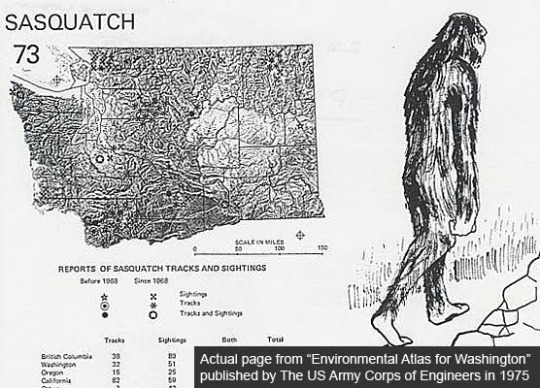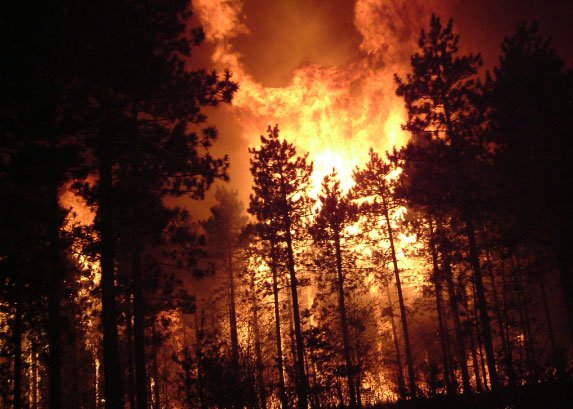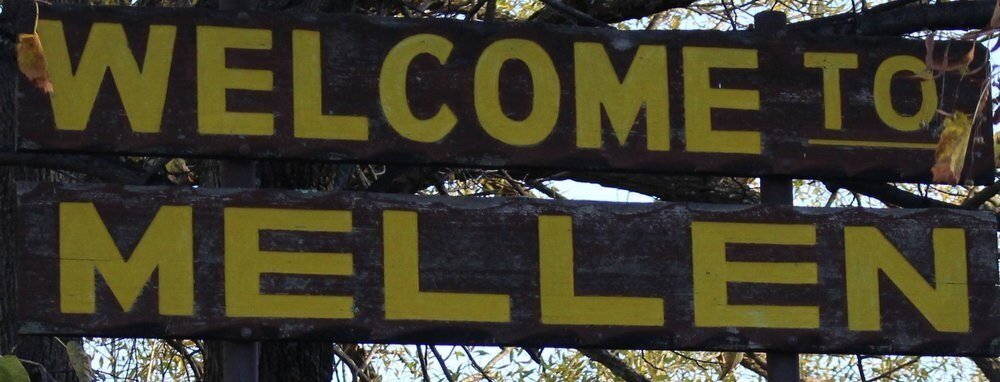Cryptid History: The U.S. Army Corps of Engineers & Bigfoot
In 1975, the United States Army Corps of Engineers (Seattle District, Environmental Resources Section) released the Washington Environmental Atlas(aka: Provisional U.S. Army Corps of Engineers Environmental Reconnaissance Inventory of the State of Washington 1975), a 114 page book that cost over $200,000 to make and over 3yrs to research and compile. The atlas contains official maps, graphs, status levels, and reports regarding phytogeography, zoogeography, physical geography, and land use borders for the state of Washington. Also included are archeological sites, rivers and lakes of environmental interest, notable geological features and historical and contemporary points of interest. The book went into great detail describing the native plants of the state (Sitka Spruce, Pacific Dogwood, Wood Rose, Yellow-Eyed Grass, etc.) as well as the native animals (Bald Eagle, Coastal Cutthroat Trout, Roosevelt Elk, American Pika, etc.). Some species were even given their own individual pages which provided even more detail than other species. One of these native creatures that were given their own page is the legendary Cryptid known as Bigfoot.
The official information and description of Sasquatch from the 1975 atlas is as follows: “The very existence of Sasquatch, or “Big Foot” as it is sometimes known, is hotly disputed. Some profess to be open-minded about the matter, although stating that not one piece of evidence will withstand serious scientific scrutiny. Others, because of a particular incident or totality of reports over the years, are convinced that Sasquatch is a reality. Alleged Sasquatch hair samples inspected by F.B.I. laboratories resulted in the conclusion that no such hair exists on any human or presently-known animal for which such data are available.
Information from alleged sightings, tracks, and other experiences conjures up the picture of an ape-like creature standing between 8 and 12 feet tall, weighing in excess of 1,000 pounds, and taking strides of up to 6 feet. Plaster casts have been made of tracks showing a large, squarish foot 14 to 24 inches in length and 5 to 10 inches in breadth. Reported to feed on vegetation and some meat, the Sasquatch is covered with long hair, except for the face and hands, and has a distinctly humanlike form. Sasquatch is very agile and powerful with the endurance to cover a vast range in search of food, shelter, and others of its kind. It is apparently able to see at night and is extremely shy, leaving minimal evidence of its presence. Tracks are presently the best evidence of its existence. A short film of an alleged female Sasquatch was shot in northern California which, although scoffed at, shows no indications of fabrication.
If Sasquatch is purely legendary, the legend is likely to be a long time in dying. On the other hand, if Sasquatch does exist, then with the Sasquatch hunts being mounted and the increasing human population, it seems likely that some hard evidence may soon be in hand. Legendary or actual, Sasquatch excites a great popular interest in Washington.”
As soon as the atlas was released to the public, residents of Washington instantly took it as proof that the United States government officially regarded Sasquatch as a living, breathing, existing creature. Why else would the Army Corps of Engineers list Bigfoot within its native species list if it didn’t actually exist? Why would maps showcase sighting locations as well as breakdowns of the evidence found at encounter sites be published for the masses if this creature wasn’t real? Newspapers of the day went wild with the story and articles popped up all over the place speaking about how the Engineering Crops had finally done what no agency had been willing to do before, officially recognize the existence of the big guy himself. But the government of Washington and the U.S. Army Corps of Engineers - Seattle District had other things to say on the matter.
While officially stating that Bigfoot did truly appear in the atlas, the government of Washington made it a point to make it known that Bigfoot was not an officially recognized species of the State of Washington, or the United States for that matter. The creature was regarded as a local legend and myth, nothing more. They made it known to the public that the 1975 atlas project had many participants and contributors, some that worked within the Corps, and others that were hired from the outside. It was one of these outside hired contractors that took it upon themselves to create the page detailing Sasquatch. It was recognized as nothing more than a tongue-in-cheek addition to the book that the project leaders felt some readers and researchers might find humorous. Needless to say, many true believers did not accept this answer. Their reason for not believing the official statement rested solely on one issue, why would an official government publication that cost over $200,000 to make (which if you adjust for inflation would be $911,464.35 today) waste money on a full page joke and why would that joke be the only one found within all 114 pages? Immediately people cried conspiracy at the fact the U.S. government appeared to be actively trying to backtrack on what its official report stated, but the final answer was given an it would not change regardless of how many people shouted.
After reading into the wild history of Bigfoot and the Washington Environmental Atlas of 1975, one can understand why the legendary North American Ape would be included in its pages. The Cryptid has a long history within the state of Washington and it only seems fitting that it should be included among other sights, locations, and areas/objects with great historical and contemporary interest/significance. It doesn’t matter if it’s a real page detailing an actual living creature, or a “joke” page documenting a well-known legend, all that matters is that historically documented occurrences like this help keep the legend of Bigfoot alive. Things like this get people talking and help open a dialogue on other cryptid creatures that fall into the same category as Sasquatch. Stories like this help push those who legitimately want to believe that these creatures are real out into the world in order to search, explore, and prove their existence. Without stories like this, how would new discoveries be made, famous mysteries be solved, and longtime legends be proven real? Simply put, they wouldn’t.
If you are interested in seeing the Washington Environmental Atlas of 1975 for yourself, they can still be found in various libraries across the United States. Some can also be found within the library collections of respected universities. Also, if you are curious about whether or not Sasquatch is still considered to be a native species of Washington, you can look here.
-The Pine Barrens Institute
*Image Credit: Public Domain
Do you have a strange tale, family legend, or odd sighting you would like to report? Get in touch with us here to share what you know!
Want more monster stories in your life? If the answer is yes, then make sure to check out our book ‘Monsters In Print: A Collection Of Curious Creatures Known Mostly From Newspapers’, available now from Amazon!
Make sure to also check out our shop for official PBI shirts, totes, buttons, and stickers!































